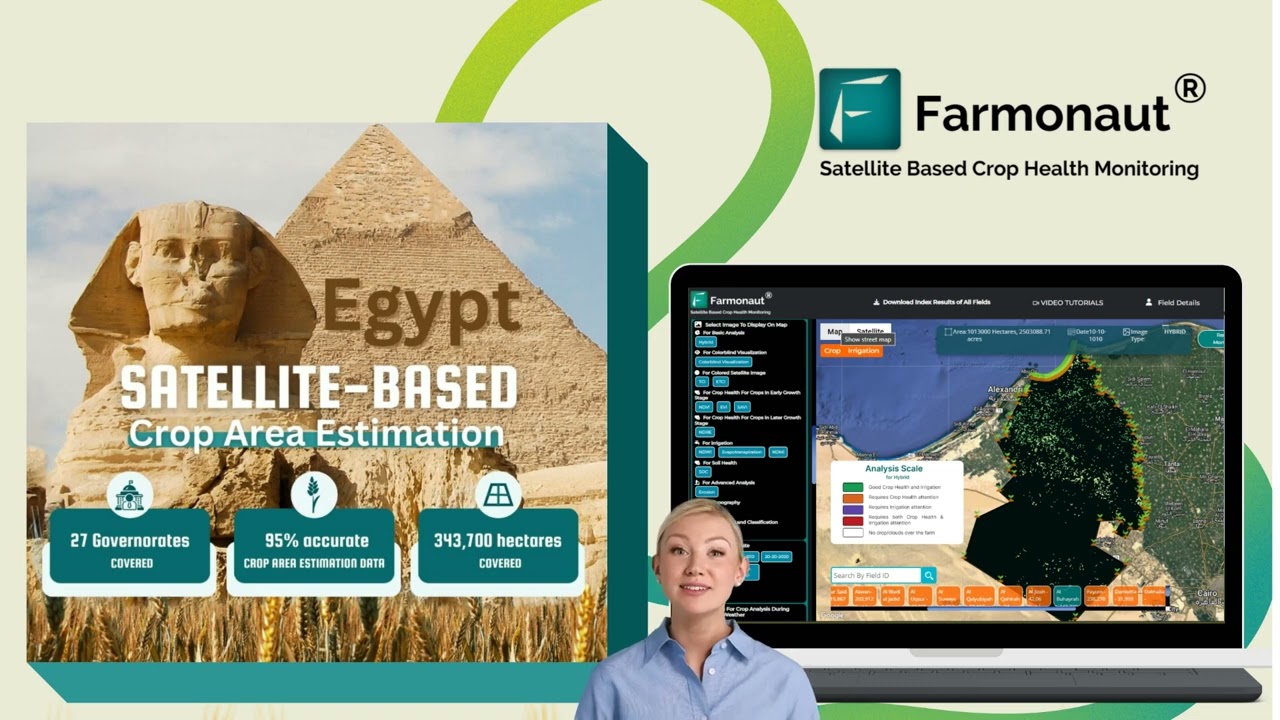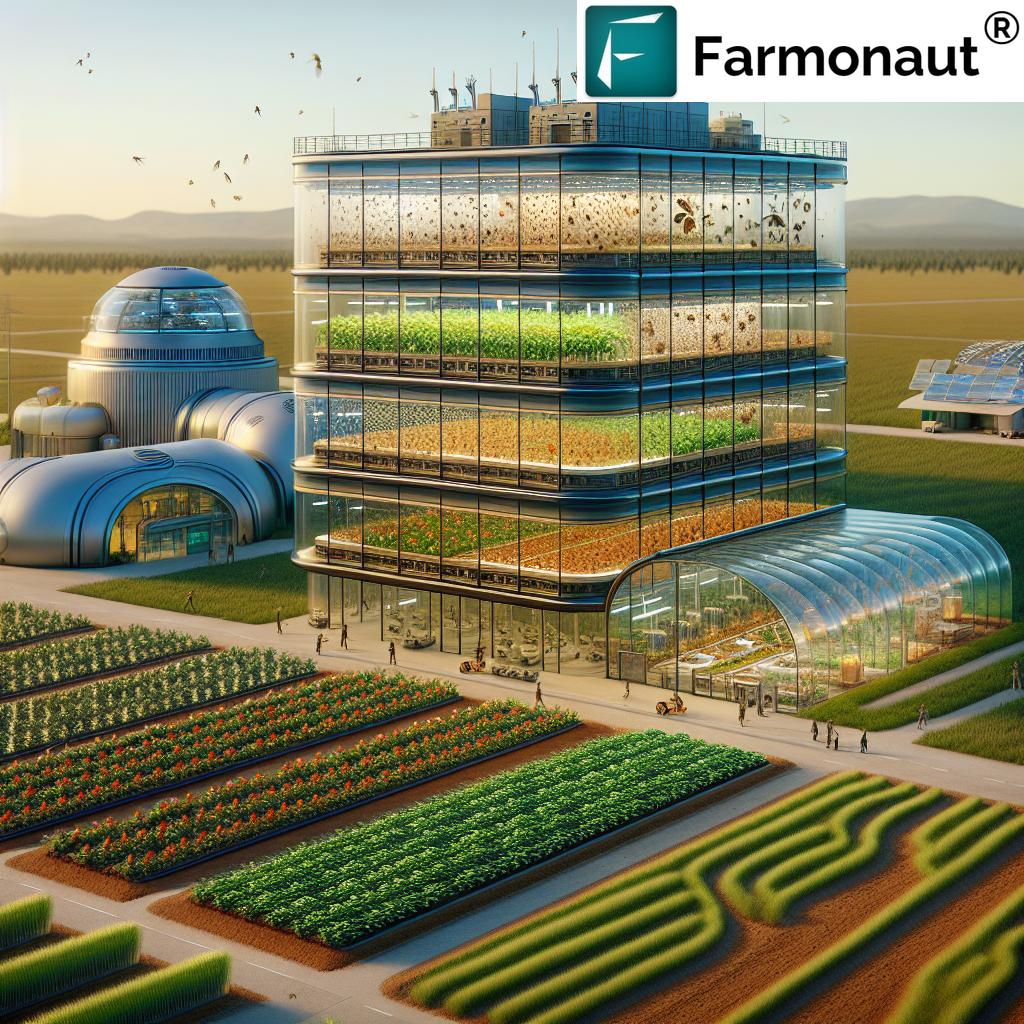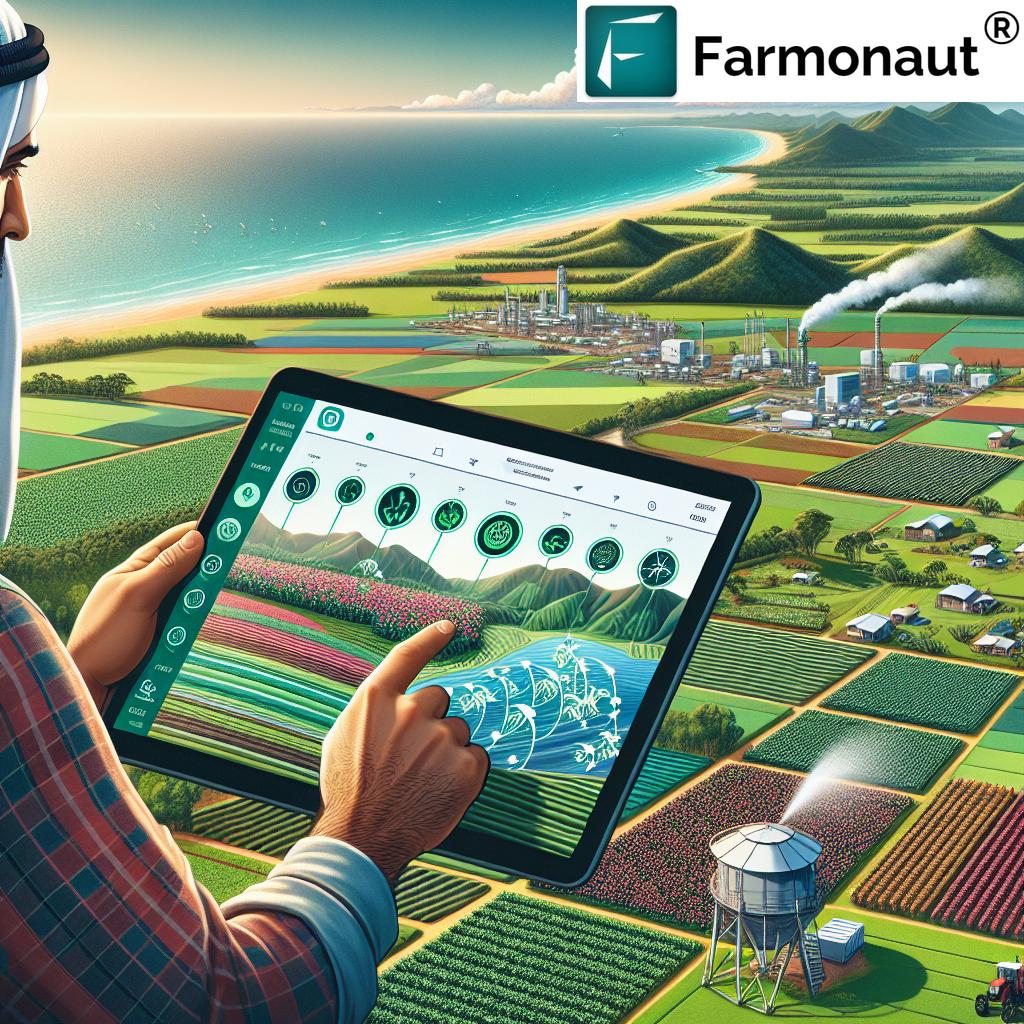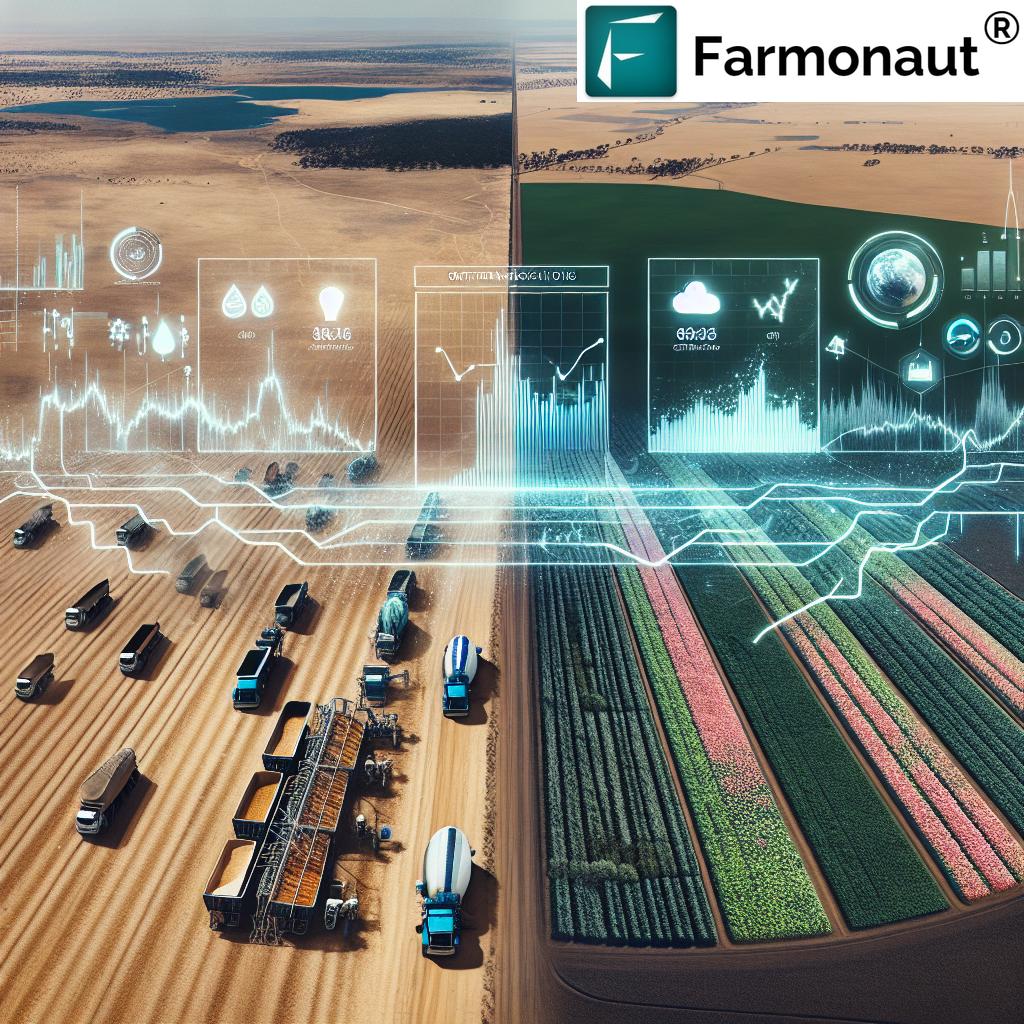Australian Agriculture’s Climate-Smart Future: Innovating for Sustainable Farming and Global Competitiveness
“Australian agriculture contributes approximately 13% of the country’s total greenhouse gas emissions.”
As we delve into the fascinating world of Australian agriculture and its journey towards a climate-smart future, it’s crucial to understand the challenges and opportunities that lie ahead. In this comprehensive blog post, we’ll explore how global responses to climate change are reshaping the agricultural landscape in Australia and beyond.
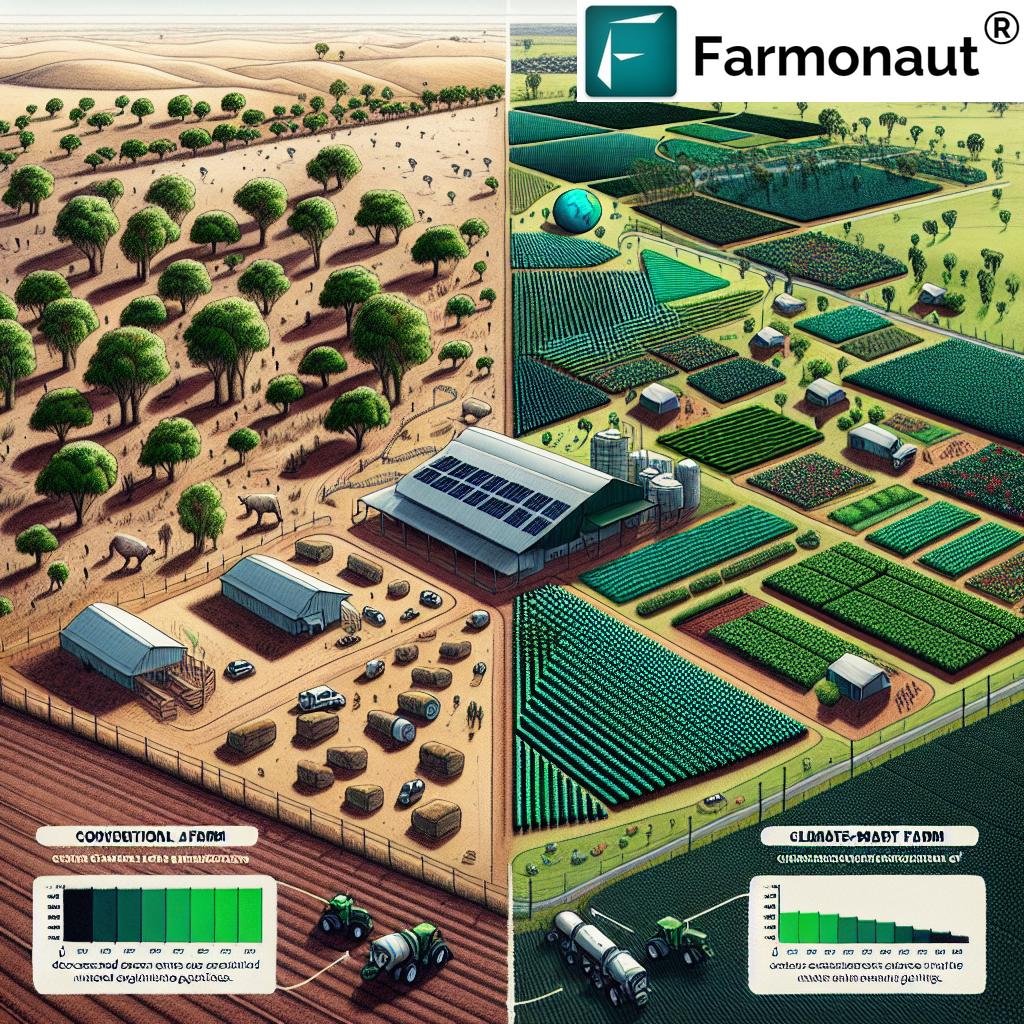
The Climate Change Challenge in Australian Agriculture
Climate change presents a significant challenge to Australian agriculture, a sector that has long been a cornerstone of the nation’s economy. As one of the world’s leading agricultural exporters, Australia faces unique pressures to adapt to changing environmental conditions while maintaining its global competitiveness.
- Rising temperatures and changing rainfall patterns
- Increased frequency and severity of extreme weather events
- Shifts in pest and disease prevalence
- Changing growing seasons and crop suitability
These factors collectively pose a substantial threat to agricultural productivity and sustainability. However, they also present opportunities for innovation and adaptation that could position Australian agriculture at the forefront of climate-smart farming practices.
Global Responses to Climate Change in Agriculture
As countries worldwide commit to reducing greenhouse gas emissions in line with the Paris Agreement, the agricultural sector is under increasing pressure to contribute to these efforts. This global shift is reshaping market demands and driving changes in farming practices across the world.
- Adoption of sustainable farming practices
- Development of climate-resilient crops
- Implementation of precision agriculture technologies
- Transition towards low-emission agricultural products
These global trends are creating both challenges and opportunities for Australian producers. To maintain their competitive edge in international markets, Australian farmers must adapt to these changing conditions and embrace climate-smart agriculture.
Sustainable Farming Practices: The Foundation of Climate-Smart Agriculture
Sustainable farming practices are at the heart of climate-smart agriculture. These practices aim to increase productivity while reducing environmental impact and building resilience to climate change. Some key sustainable farming practices include:
- Conservation tillage
- Crop rotation and diversification
- Integrated pest management
- Efficient irrigation systems
- Agroforestry
By adopting these practices, Australian farmers can reduce their greenhouse gas emissions, improve soil health, and enhance their farms’ resilience to climate variability.
Agricultural Emissions Reduction: A Key Priority
Reducing greenhouse gas emissions from agriculture is a critical component of Australia’s national climate change strategy. The agricultural sector accounts for a significant portion of the country’s total emissions, primarily from livestock, soil management, and on-farm energy use.
To address this challenge, various strategies are being implemented:
- Improved livestock management practices
- Enhanced soil carbon sequestration
- Adoption of renewable energy on farms
- Development of low-emission fertilizers
These efforts not only contribute to national emissions reduction targets but also position Australian agriculture as a leader in sustainable food production.
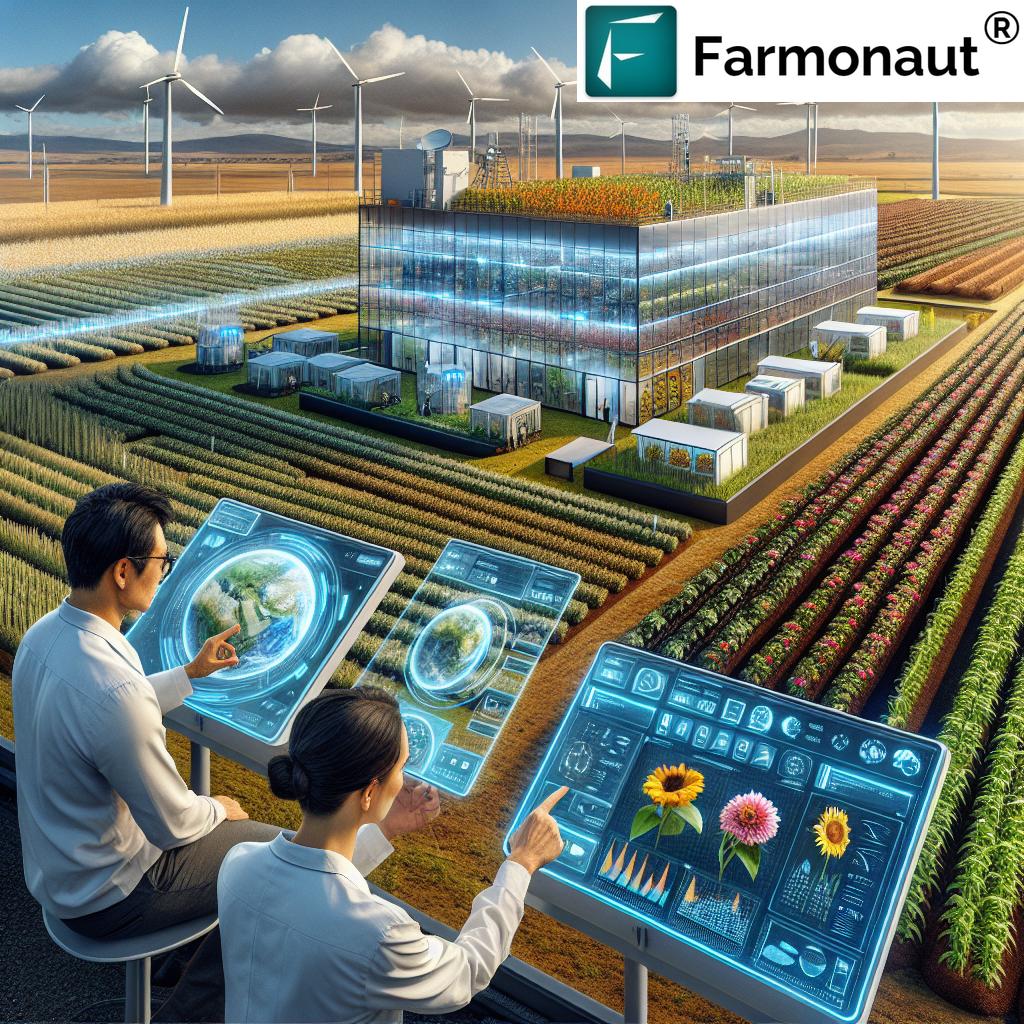
Carbon Neutral Agriculture: The Ultimate Goal
The concept of carbon neutral agriculture is gaining traction globally, and Australia is no exception. Achieving carbon neutrality in agriculture involves balancing the emissions produced by farming activities with an equivalent amount of carbon sequestration or offset.
Several initiatives are underway to support this transition:
- Carbon farming projects
- Development of carbon credit schemes for agriculture
- Research into carbon-neutral production methods
- Adoption of renewable energy sources on farms
By pursuing carbon neutrality, Australian agriculture can enhance its global reputation and access new market opportunities in a carbon-conscious world.
Climate Resilient Crops: Adapting to Changing Conditions
Developing climate-resilient crops is crucial for maintaining agricultural productivity in the face of changing environmental conditions. Australian researchers and farmers are at the forefront of this effort, working to develop crop varieties that can withstand higher temperatures, drought, and changing pest pressures.
Key focus areas include:
- Heat and drought-tolerant wheat varieties
- Salt-tolerant crops for areas affected by rising salinity
- Disease-resistant fruit and vegetable cultivars
- Water-efficient rice varieties
These climate-resilient crops will play a vital role in ensuring food security and maintaining Australia’s position as a major agricultural exporter.
Precision Agriculture Technology: Revolutionizing Farming Practices
Precision agriculture technology is transforming the way farmers manage their land and resources. By leveraging data-driven insights and advanced tools, farmers can optimize their operations for both productivity and sustainability.
Key precision agriculture technologies include:
- GPS-guided machinery
- Remote sensing and satellite imagery
- Soil and crop sensors
- Variable rate technology for input application
- Farm management software
These technologies enable farmers to make more informed decisions, reduce waste, and minimize environmental impact while maximizing yields.
At Farmonaut, we’re proud to be at the forefront of this technological revolution in agriculture. Our satellite-based farm management solutions provide farmers with real-time insights into crop health, soil moisture, and other critical metrics. By leveraging our API and API Developer Docs, agricultural businesses can integrate cutting-edge satellite data into their own systems, driving innovation and efficiency across the sector.
“Climate-smart agriculture practices can increase crop yields by up to 30% while reducing water usage by 20%.”
Greenhouse Gas Mitigation in Farming: Strategies for Reduction
Mitigating greenhouse gas emissions from farming activities is a critical aspect of climate-smart agriculture. Australian farmers are implementing various strategies to reduce their carbon footprint:
- Methane reduction in livestock through improved feed management
- Nitrous oxide reduction through precision fertilizer application
- Carbon sequestration through improved soil management practices
- Energy efficiency measures and adoption of renewable energy sources
These mitigation strategies not only contribute to national emissions reduction targets but also often result in improved farm efficiency and reduced operating costs.
Agricultural Productivity and Climate Change: Balancing Act
Maintaining and improving agricultural productivity in the face of climate change is a delicate balancing act. Australian farmers are adopting various strategies to achieve this balance:
- Diversification of crop and livestock systems
- Adoption of climate-smart technologies
- Improved water management techniques
- Investment in research and development
By focusing on these areas, Australian agriculture can continue to thrive even as environmental conditions change.
Low Emission Agricultural Products: Meeting Market Demands
As global consumers become increasingly environmentally conscious, there is growing demand for low-emission agricultural products. Australian producers are responding to this trend by:
- Developing carbon-neutral beef and lamb
- Producing low-emission dairy products
- Implementing sustainable wine production practices
- Exploring markets for plant-based protein alternatives
By focusing on low-emission products, Australian agriculture can tap into new market opportunities and maintain its competitive edge in the global marketplace.
Climate Smart Agriculture: A Holistic Approach
Climate-smart agriculture (CSA) is an integrated approach to managing landscapes—cropland, livestock, forests and fisheries—that addresses the interlinked challenges of food security and climate change. It aims to sustainably increase agricultural productivity, adapt and build resilience to climate change, and reduce greenhouse gas emissions where possible.
Key elements of climate-smart agriculture include:
- Sustainable intensification of production systems
- Climate-resilient crop varieties and livestock breeds
- Improved resource use efficiency
- Enhanced risk management through early warning systems and insurance
- Supportive policies and institutions
By embracing CSA, Australian farmers can ensure the long-term sustainability and profitability of their operations while contributing to global climate change mitigation efforts.
The Role of Technology in Climate-Smart Agriculture
Technology plays a crucial role in enabling and accelerating the adoption of climate-smart agricultural practices. From satellite-based monitoring systems to AI-powered predictive analytics, technological innovations are helping farmers make more informed decisions and optimize their operations for both productivity and sustainability.
At Farmonaut, we’re committed to making these advanced technologies accessible to farmers of all scales. Our platform offers affordable, user-friendly solutions for satellite-based crop monitoring, AI-driven advisory services, and blockchain-based traceability. Whether you’re accessing our services through our web app, Android app, or iOS app, you’ll have the power of cutting-edge agricultural technology at your fingertips.
Climate-Smart Agriculture Strategies and Their Impact
| Strategy | Greenhouse Gas Reduction Potential | Productivity Improvement | Implementation Challenges |
|---|---|---|---|
| Precision Agriculture | 15-25% | 10-20% | High initial costs, technical expertise required |
| Crop Diversification | 5-10% | 15-25% | Market access for new crops, knowledge gaps |
| Conservation Tillage | 20-30% | 5-15% | Initial yield reductions, weed management |
| Improved Water Management | 10-20% | 20-30% | Infrastructure costs, water rights issues |
The Economic Implications of Climate-Smart Agriculture
Transitioning to climate-smart agriculture has significant economic implications for Australian farmers and the broader agricultural sector. While there may be initial costs associated with adopting new technologies and practices, the long-term benefits can be substantial:
- Increased productivity and efficiency
- Reduced input costs through precision management
- Access to premium markets for sustainable products
- Enhanced resilience to climate-related risks
- Potential revenue from carbon credits and ecosystem services
By embracing climate-smart agriculture, Australian farmers can position themselves for long-term economic success in a changing global market.
Policy Framework for Climate-Smart Agriculture in Australia
The Australian government has implemented various policies and initiatives to support the transition to climate-smart agriculture. These include:
- The National Soil Strategy
- The Future Drought Fund
- The Emissions Reduction Fund
- Research and development funding through organizations like CSIRO
These policies provide a supportive framework for farmers and agribusinesses to invest in sustainable practices and technologies.
International Competitiveness and Climate-Smart Agriculture
As global markets increasingly prioritize sustainable production methods, Australian agriculture’s adoption of climate-smart practices is crucial for maintaining international competitiveness. By positioning itself as a leader in sustainable agriculture, Australia can:
- Differentiate its products in global markets
- Meet the growing demand for low-emission agricultural products
- Comply with evolving international trade standards
- Attract investment in sustainable agricultural technologies
This focus on sustainability and climate-smart practices will be key to ensuring the long-term success of Australian agriculture in the global marketplace.
The Future of Australian Agriculture: Embracing Innovation and Sustainability
As we look to the future, it’s clear that Australian agriculture must continue to innovate and adapt to meet the challenges posed by climate change. By embracing climate-smart practices and leveraging cutting-edge technologies, Australian farmers can not only mitigate environmental impacts but also enhance their productivity and global competitiveness.
The journey towards a climate-smart agricultural future will require ongoing collaboration between farmers, researchers, policymakers, and technology providers. At Farmonaut, we’re committed to supporting this transition by providing innovative, accessible solutions that empower farmers to make data-driven decisions and optimize their operations for both productivity and sustainability.
As we move forward, the Australian agricultural sector has the opportunity to lead the world in sustainable farming practices, setting new standards for productivity, resilience, and environmental stewardship. By embracing this challenge, we can ensure a prosperous and sustainable future for Australian agriculture in the face of global climate change.
Frequently Asked Questions (FAQ)
- What is climate-smart agriculture?
Climate-smart agriculture is an approach that helps guide actions to transform and reorient agricultural systems to effectively support development and ensure food security in a changing climate. It aims to tackle three main objectives: sustainably increasing agricultural productivity and incomes, adapting and building resilience to climate change, and reducing and/or removing greenhouse gas emissions, where possible. - How does climate change impact Australian agriculture?
Climate change affects Australian agriculture through rising temperatures, changing rainfall patterns, increased frequency and severity of extreme weather events, shifts in pest and disease prevalence, and alterations in growing seasons and crop suitability. - What are some key sustainable farming practices?
Key sustainable farming practices include conservation tillage, crop rotation and diversification, integrated pest management, efficient irrigation systems, and agroforestry. - How can precision agriculture technology help in climate-smart farming?
Precision agriculture technology, such as GPS-guided machinery, remote sensing, and variable rate technology, helps farmers optimize resource use, reduce waste, and minimize environmental impact while maximizing yields. - What are climate-resilient crops?
Climate-resilient crops are varieties developed to withstand changing environmental conditions such as higher temperatures, drought, and changing pest pressures. Examples include heat and drought-tolerant wheat varieties and salt-tolerant crops. - How can Australian farmers reduce their greenhouse gas emissions?
Farmers can reduce emissions through improved livestock management, enhanced soil carbon sequestration, adoption of renewable energy on farms, and use of low-emission fertilizers. - What is carbon neutral agriculture?
Carbon neutral agriculture involves balancing the emissions produced by farming activities with an equivalent amount of carbon sequestration or offset, resulting in net zero carbon emissions. - How does climate-smart agriculture affect productivity?
Climate-smart agriculture aims to increase productivity while reducing environmental impact and building resilience to climate change. It can lead to improved yields, reduced input costs, and enhanced farm efficiency. - What role does technology play in climate-smart agriculture?
Technology plays a crucial role in enabling climate-smart agriculture by providing tools for data collection, analysis, and decision-making. This includes satellite-based monitoring systems, AI-powered predictive analytics, and blockchain-based traceability solutions. - How can Australian agriculture maintain its global competitiveness in the face of climate change?
Australian agriculture can maintain its competitiveness by adopting climate-smart practices, developing low-emission products, leveraging advanced technologies, and positioning itself as a leader in sustainable food production.
Farmonaut Subscriptions
Ready to embrace the future of climate-smart agriculture? Explore Farmonaut’s innovative solutions:
Join us in shaping a sustainable and prosperous future for Australian agriculture!



